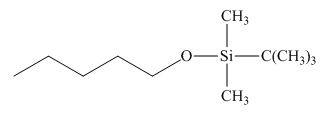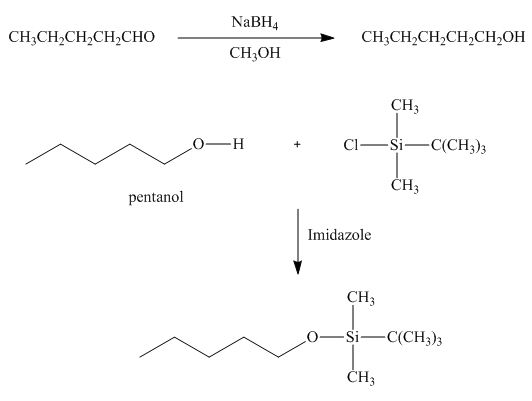
Draw the products formed when pentanal
a.
b.
c.
d.
e.
f.
g.
h.
i.
j.
k.
l. The [product in (a), then TBDMS-Cl, imidazole.
(a)
Interpretation: The product formed by the reaction of pentanal with
Concept introduction: The substitution reaction involves the replacement of one functional group by other functional group. In nucleophilic substitution an electron rich species attack the species that is deficient in electrons. The electrophile and the leaving group together form a substrate. The nucleophile attacks over the substrate and there occurs the removal of leaving group from the substrate.
Answer to Problem 20.38P
The product formed by the reaction of pentanal with
![]()
Figure 1
Explanation of Solution
The reaction that shows the formation of product when pentanal reacts with

Figure 2
In the given reaction, sodium borohydride is used as a reducing agent. Sodium borohydride is used to for the reduction of carbonyl compounds to alcohols.
The product formed by the reaction of pentanal with
(b)
Interpretation: The product formed by the reaction of pentanal with
Concept introduction: The substitution reaction involves the replacement of one functional group by other functional group. In nucleophilic substitution an electron rich species attack the species that is deficient in electrons. The electrophile and the leaving group together form a substrate. The nucleophile attacks over the substrate and there occurs the removal of leaving group from the substrate.
Answer to Problem 20.38P
The product formed by the reaction of pentanal with
![]()
Figure 1
Explanation of Solution
The reaction that shows the formation of product when pentanal reacts with

Figure 3
In the given reaction,
The product formed by the reaction of pentanal with
(c)
Interpretation: The product formed by the reaction of pentanal with the
Concept introduction: Addition of hydrogen takes place across a double bond of alkenes to form alkanes. This process is known as hydrogenation. It takes place in the presence of catalysts such as nickel, platinum or palladium.
Answer to Problem 20.38P
The product formed by the reaction of pentanal with the
![]()
Figure 1
Explanation of Solution
The reaction that shows the formation of product when

Figure 4
In the given reaction, hydrogenation of alkene takes place in the presence of palladium.
The product formed by the reaction of pentanal with the
(d)
Interpretation: The product formed by the reaction of pentanal with
Concept introduction:
Answer to Problem 20.38P
No product is formed by the reaction of pentanal with
Explanation of Solution
The product formed by the reaction of pentanal with
![]()
Figure 5
No product is formed by the reaction of pentanal with
(e)
Interpretation: The product formed by the reaction of pentanal with the
Concept introduction: Organometallic reagents like
Answer to Problem 20.38P
The product formed by the reaction of pentanal with the
![]()
Figure 6
Explanation of Solution
The product formed by the reaction of pentanal with the

Figure 7
The product formed by the reaction of pentanal with the
(f)
Interpretation: The product formed by the reaction of pentanal with
Concept introduction:
Answer to Problem 20.38P
The product formed by the reaction of pentanal with
![]()
Figure 6
Explanation of Solution
The product formed by the reaction of pentanal with

Figure 8
The product formed by the reaction of pentanal with
(g)
Interpretation: The product formed by the reaction of pentanal with the
Concept introduction: Grignard reagent is prepared by the reaction of alkyl or aryl bromide with magnesium metal in the presence of ether. The reaction of Grignard reagent with an aldehyde/ketone followed by hydrolysis yields an alcohol.
Answer to Problem 20.38P
The product formed by the reaction of pentanal with the

Figure 9
Explanation of Solution
The reaction that shows the formation of product when

Figure 10
In the given reaction, Grignard reagent is used. This reagent attacks on the carbonyl compound to form alkoxides. In the next step, protonation with water takes place to give the final product.
The product formed by the reaction of pentanal with the
(h)
Interpretation: The product formed by the reaction of pentanal with
Concept introduction: Organometallic reagents like
Answer to Problem 20.38P
The product formed by the reaction of pentanal with

Figure 11
Explanation of Solution
The reaction that shows the formation of product when

Figure 12
The product formed by the reaction of pentanal with
(i)
Interpretation: The product formed by the reaction of pentanal with
Concept introduction: Organometallic reagents like
Answer to Problem 20.38P
No product formed by the reaction of pentanal with
Explanation of Solution
The product formed by the reaction of pentanal with

Figure 13
Aldehydes do not react with organo copper reagent because these reagents are less reactive and cannot attack to the electrophilic centre of the aldehyde group.
(j)
Interpretation: The product formed by the reaction of pentanal with
Concept introduction: Organometallic reagents like
Answer to Problem 20.38P
The product formed by the reaction of pentanal with

Figure 14
Explanation of Solution
The product formed by the reaction of pentanal with

Figure 15
(k)
Interpretation: The product formed by the reaction of pentanal with
Concept introduction: Organometallic reagents like
Answer to Problem 20.38P
The product formed by the reaction of pentanal with

Figure 16
Explanation of Solution
The reaction that shows the formation of product when

Figure 17
(l)
Interpretation: The product formed by the reaction of pentanal with
Concept introduction: Organometallic reagents like
Answer to Problem 20.38P
The product formed by the reaction of pentanal with

Figure 18
Explanation of Solution
The product formed by the reaction of pentanal with

Figure 19
In the given reaction, sodium borohydride is used as a reducing agent. Sodium borohydride is used to for the reduction of carbonyl compounds to alcohols.
The product formed by the reaction of pentanal with the
Want to see more full solutions like this?
Chapter 20 Solutions
Package: Loose Leaf for Organic Chemistry with Biological Topics with Connect Access Card
- The decimolar calomel electrode has a potential of 0.3335 V at 25°C compared to the standard hydrogen electrode. If the standard reduction potential of Hg22+ is 0.7973 V and the solubility product of Hg2Cl2 is 1.2x 10-18, find the activity of the chlorine ion at this electrode.Data: R = 8.314 J K-1 mol-1, F = 96485 C mol-1, T = 298.15 K.arrow_forward2. Add the following group of numbers using the correct number of significant figures for the answer. Show work to earn full credit such as rounding off the answer to the correct number of significant figures. Replace the question marks with the calculated answers or write the calculated answers near the question marks. 10916.345 37.40832 5.4043 3.94 + 0.0426 ? (7 significant figures)arrow_forwardThe emf at 25°C of the cell: Pt l H2(g) l dis X:KCl (sat) l Hg2Cl2(s) l Hg l Pt was 612 mV. When solution X was replaced by normal phosphate buffer solution with a pH of 6.86, the emf was 741 mV. Calculate the pH of solution X.arrow_forward
- Indicate how to calculate the potential E of the reaction Hg2Cl2(s) + 2e ⇄ 2Hg + 2Cl- as a function of the concentration of Cl- ions. Data: the solubility product of Hg2Cl2.arrow_forwardHow can Beer’s Law be used to determine the concentration in a selected food sample. Provide an in-depth discussion and examples of this.arrow_forwardb) H3C- H3C Me CH 3 I HN Me H+arrow_forward
- Using Luther's rule, determine the reference potentials of the electrodes corresponding to the low stability systems Co³+/Co and Cr²+/Cr from the data in the table. Electrodo ΕΝ Co²+/Co Co3+/Co²+ -0,28 +1,808 Cr³+ / Cr -0,508 Cr3+ / Cr²+ -0,41arrow_forwardThe molecule PYRIDINE, 6tt electrons and is there pore aromuntre and is Assigned the Following structure contenus Since aromatk moleculey undergo electrophilic allomatic substitution, Pyridine should undergo The Following reaction + HNO3 12504 a. write all of the possible Mononitration Products that could Result From this roaction Based upon the reaction the reaction mechanism determine which of these producty would be the major Product of the hegetionarrow_forwardUsing Benzene as starting materia Show how each of the Following molecules could Ve synthesked 9. CHI d. 10450 b 0 -50311 ८ City -5034 1-0-650 e NO2arrow_forward
- BA HBr of the fol 1)=MgCI 2) H₂O major NaOEt Ts Cl Py (pyridine) 1) 03 2) Me2S 1arrow_forward4. Provide a clear arrow-pushing mechanism for the following reactions. Do not skip proton transfers, do not combine steps, and make sure your arrows are clear enough to be interpreted without ambiguity. a) NHBoc ⚫OBn HO. H3C CO2CH3 -OBn H3C H3C. H3C. NHBOC CI CO2CH3arrow_forwardDraw structures of the following compounds and identify their role: mCPBA (MCPBA) DMS Py 9-BBN LAH Sia₂BH TsCI PCC t-BuOK LDA MeLi n-BuLi DMSO DMF Sodium Borohydride Lithium DiisopropylAmide 2arrow_forward
 ChemistryChemistryISBN:9781305957404Author:Steven S. Zumdahl, Susan A. Zumdahl, Donald J. DeCostePublisher:Cengage Learning
ChemistryChemistryISBN:9781305957404Author:Steven S. Zumdahl, Susan A. Zumdahl, Donald J. DeCostePublisher:Cengage Learning ChemistryChemistryISBN:9781259911156Author:Raymond Chang Dr., Jason Overby ProfessorPublisher:McGraw-Hill Education
ChemistryChemistryISBN:9781259911156Author:Raymond Chang Dr., Jason Overby ProfessorPublisher:McGraw-Hill Education Principles of Instrumental AnalysisChemistryISBN:9781305577213Author:Douglas A. Skoog, F. James Holler, Stanley R. CrouchPublisher:Cengage Learning
Principles of Instrumental AnalysisChemistryISBN:9781305577213Author:Douglas A. Skoog, F. James Holler, Stanley R. CrouchPublisher:Cengage Learning Organic ChemistryChemistryISBN:9780078021558Author:Janice Gorzynski Smith Dr.Publisher:McGraw-Hill Education
Organic ChemistryChemistryISBN:9780078021558Author:Janice Gorzynski Smith Dr.Publisher:McGraw-Hill Education Chemistry: Principles and ReactionsChemistryISBN:9781305079373Author:William L. Masterton, Cecile N. HurleyPublisher:Cengage Learning
Chemistry: Principles and ReactionsChemistryISBN:9781305079373Author:William L. Masterton, Cecile N. HurleyPublisher:Cengage Learning Elementary Principles of Chemical Processes, Bind...ChemistryISBN:9781118431221Author:Richard M. Felder, Ronald W. Rousseau, Lisa G. BullardPublisher:WILEY
Elementary Principles of Chemical Processes, Bind...ChemistryISBN:9781118431221Author:Richard M. Felder, Ronald W. Rousseau, Lisa G. BullardPublisher:WILEY





